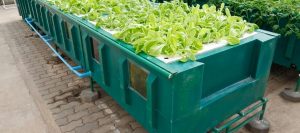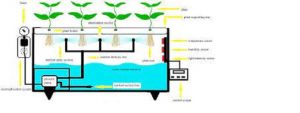#.The Ultimate Guide to Get Started with Aeroponic Systems.
What is aeroponics?

Aeroponics is one method of growing marijuana plants where root systems are suspended in the air within an enclosed chamber and then sprayed with water. Aeroponics is typically utilized to begin cannabis clones to ensure they have an established root system before being planted in soil or another medium for growing. However, it could also be utilized to cultivate fully-grown plants.
The method of growing was invented in the first half of the second decade of the 20th century to serve as an approach to studying a plant’s root system. It was initially developed for research purposes only, but now it has become an increasingly popular method of cultivating cannabis plant clones and plants.
What is an AEROPONIC System?

Aeroponics is actually a part of the hydroponic system. But, in the hydroponics technique, water is used as the growing medium. By contrast, aeroponics has no medium whatsoever. The method was developed in the 1940s, and since that time, numerous researchers have contributed to the research and application of this technique. Aeroponics is regarded as one of the most effective methods to cultivate plants in soil-free environments. This technique is growing because of an obvious demand for a simpler method of growing plants.
Plants aren’t encased in any solid materials like Rockwool or even soil in the aeroponic system. Instead, they are suspended inside a grow chamber within a closed-loop system. The roots are then sprayed with nutrient-rich water or fine high-pressure mist that contains nutrient-rich solutions at specific intervals.
This makes aeroponics a more sophisticated form of hydroponics than the systems for wicking deep water cultivation and other varieties. Every plant needs nutrients, so the organism has to spend an immense amount of energy cultivating roots to discover these nutrient-rich pockets in the soil that will aid in flower development and development. Through aeroponics and hydroponics, nutrients are delivered directly to the root.
Compared to conventional hydroponic plants, plants tend to grow more quickly and absorb more nutrients since they are exposed to more oxygen. Furthermore, because there is no space for pathogens or debris to live, there are fewer risks of diseases affecting the root zone.
But, it is important to be aware that the chambers of an aeroponic system are always soaked with nutrients, which makes them perfect for harmful fungi and bacteria to grow. Therefore, it is essential to wash and sterilize the misters before use regularly and remove and treat the chambers using the hydrogen peroxide solution that can be bought at any good hydroponic shop.
How Does the AEROPONIC System Work?

In the aeroponic system, plants are generally placed into the top holes that are on top of a reservoir before being placed inside a sealed pot.
Because there are no root zone media that plants can anchor into, it is necessary to create an anchor collar to ensure that items remain in their place. The collars should be strong enough to keep plants upright and hold their roots in position. However, they must be flexible enough to allow room for roots to expand.
The sprinkler and pump system generates the vapor (which is a hydro-atomized composition consisting of water, nutrients, and growth hormones) from the nutrient-rich solution. It then sprays the mist inside the reservoir, covering the plant’s roots and being absorbed by them. The mist provides precisely the amount of water that stimulates the plant’s growth, allowing it to grow turgidly.
The timer provides the scheduled spray intervals and durations for the plants. Many people believe that the plants in an aeroponic system will be less robust than those in hydroponics. However, this isn’t the case. The secret of an aeroponic system lies in the volume of oxygen pumped to the roots without a root zone medium restricting it.
Due to this, the roots of plants will expand quickly and in a humid, air-rich, and moist environment. If you’d like to know the rate of their growth, simply raise the chamber to observe the growth rate.
The Ultrasound Aeroponic System

The roots are vital to plants because of their vital role in absorbing nutrients and water from the soil. However, research into roots is usually restricted by the access it has. In our lab, we employ the ultrasonic aeroponic system. This plant-growth technology allows complete ability to access the roots and examine the roots’ responses to different environmental and biotic stressors.
The ultrasound aeroponic produces a small cool spray (i.e., 5-millimeter dia. droplets) of nutritive solution that nourishes the plants, allowing the roots’ management. The aeroponic ultrasound system provides new opportunities to study root responses to biotic stresses by altering the composition and chemical content of mist (e.g., extremely high salts and the deprivation of nutrients like N, K, P, Fe) or the physical characteristics of the plant’s environment (e.g., extreme temperature or high drought stress). Additionally, its use can be used in conjunction with the treatment of roots by biological agents (e.g., Bradyrhizobium japonicum treatment for soybean root; Qiao and Libault 2013).
Another benefit of the plant’s response to these systems based on ultrasound is the high number of root hair cells in their root systems. Combining the ultrasound aeroponics system and the root hair cell isolation procedure can produce more than 1 gram of hair cells from 60-week-old soybeans, common beans, barrel medic, and sorghum.
An Intermittent Aeroponics System

A contribution from the Horticulture Dept., College of Agricultural and Life Sciences, University of Wisconsin-Madison.
An intermittent aeroponic system was developed and tested to determine its potential in plant growth studies. Cucumber (Cucumis Sativus) was produced in the system starting from the cotyledon stage until the point of flowering and fruiting within days on a misting plan of 7 s, at 10-min intervals using approximately one-half the strength of Hoagland’s solution. The root environment was controlled by 20 + 1.1 degC, but different temperatures could be set. The root growth rate was fast, with good branching and root hair growth. The proposed system for plant growth gives the benefits of quick entry into the roots and control of the composition of the misting solution about the concentration of elements or an application of a growth regulator at different phases in the development of the root. It could also be the ability to test short-term water stress and its relation to the development of plants. The system described in this article has been operating all the time for 32 weeks without any operational issues.
What are the Different Types of Aeroponics Systems?
LPA (Low-Pressure Aeroponics) Systems

An LPA arrangement is the most commonly used system for home gardeners due to its efficiency and cost. They’re also accessible in various locations and not only to hydroponic specialists.
There is a way to build your own LPA system by using PVC for the pipes, attaching misters to them, and then using a fountain or pond pump connected to the reservoir.
There’s no special pump to run LPA systems. LPA system. You require the pressure needed to create an atmosphere of mist inside the reservoir.
The issue with choosing the correct pump for your DIY setup is that fountain and pond pumps do not typically have a PSI rating. Instead, they’re GPH (gallons per hour) and head height.
The head height is more important when selecting a suitable submersible pump for an LPA system since the higher the elevation is, the higher pressure is required to push the water to the point that it is at the level of the misters.
Just make certain that the reservoir is tall enough to handle the head’s height.
To get the best results, each spray should be directed upwards to spray over the roots. Also, each spray of the nozzles overlaps slightly. The goal is to produce an airy mist. Then, you want the water to flow across the top of the plant’s roots before it begins to drip down, and then drop into the reservoir.
The last thing you want to do is tilt the sprinklers so that the water falls directly on the roots. It will drench them and drown them, resulting in what many aeroponic growers call “soakaponics,” since the roots get wet, not mist.
Based on the dimensions of the container you’re using, you may be able to have only three sprinklers, or, for bigger setups, six or more sprinklers connected in series.
Many factors influence the water pump’s ability to create an ideal mist inside the reservoir.
- The height of the head is important and necessary because the pressure must be strong enough to move through the pipe up to the misters.
- The higher the GPH that the pump can move through the system to the required head height, the greater pressure you’ll experience.
- The number of misters that are used will impact their effectiveness since each mister is likely to cause a small reduction in pressure.
Be aware that when you are using low-pressure aeroponic systems, it is essential to utilize both ratings. GPH and the height of the head.
Remember this section:
If you aren’t sure what you’ll need to do, you should aim higher. You can decrease water pressure, but you’ll never raise it without changing to a more powerful pump.
High-Pressure Aeroponics Systems (HPA)

HPA systems are great for commercial growers, but are a very expensive setup for hobbyists and homegrown growers, and are therefore probably not the best choice unless you’re farming. This kind of setup could be considered the agricultural method for commercial use that is to come soon.
For a glimpse of how agriculture is evolving to let farms grow fresh vegetables in cities, watch this video that shows a high-tech aeroponics system in the field…
In the ’90s, that would have been considered science-fiction. Today, it’s happening.
As you can see, using HPA methods is highly complicated, and you can imagine how expensive it is to set up an operation like this. That’s why it’s only suitable for commercial farmers who need to produce more for each harvest and gain greater yields throughout the year.
A typical HPA system pump is designed to start with a pressure range of 60 to 90 PSI. The higher its power of it, the better the spray. For a top-quality system, you’ll be in the market for a pump that can deliver a continuous flow of up to 100 PSI.
Controlling the frequency is the first step to avoiding problems because they are constantly running, and you’ll find the pump requires replacement more often. That’s not even watering up to half a dozen plants. If you’re out of several hundred dollars, you face a much greater expense for pumps, misters, and tanks.
To extend the life of an HPA pump, a pressurized accumulator tank is utilized in a professional HPA system. Using an accumulator tank, pressurized water and air are utilized to ensure that the pump doesn’t need to work as much, and it can maintain a steady PSI.
Due to the expense of installing an HPA system, it is not a good idea to set up these systems for homegrown farmers. They’re ideally suited to urban farming since they can produce greater yields per crop and bigger harvests throughout the year.
This is the HPA system, which focuses on obtaining tiny droplets of water that are less than 50 microns. Low-pressure systems will not produce tiny droplets of water, but they’ll produce a fine mist produced by the pump and the sprinkler heads.

